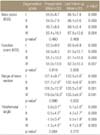Abstract
Purpose
To evaluate the influence of degenerative changes in the patellofemoral joint on the clinical results of medial unicompartmental knee arthroplasty (UKA).
Materials and Methods
Between January and December 2002, we operated on 180 cases of minimally invasive UKA using the Oxford® phase 3. Of the 180 cases, 156 were followed up for a minimum period of 5 years. Based on intraoperative degenerative findings of the patellofemoral joint, we classified cases into 4 groups (Group I-78 cases, Group II-40 cases, Group III-27 cases, Group IV-11 cases), and the clinical data were analyzed prospectively.
Results
During follow-up, which averaged 6 years and 2 months, the knee score, the knee function score, the range of knee motion and the tibiofemoral angle were improved significantly (p<0.05) in all groups. The preoperative knee score and the tibiofemoral angle in the mild degeneration group (I, II) were higher than in the severe degeneration group (III, IV) (p<0.05). On the other hand, there were no significant differences between the groups in the postoperative knee score, the knee function score, the range of knee motion and the tibiofemoral angle (p>0.05). To date, no complication or failure involving the patellofemoral joint has been observed.
Figures and Tables
References
1. Aleto TJ, Berend ME, Ritter MA, Faris PM, Meneghini RM. Early failure of unicompartmental knee arthroplasty leading to revision. J Arthroplasty. 2008. 23:159–163.

2. Repicci JA, Hartman JF. Minimally invasive unicondylar knee arthroplasty for the treatment of unicompartmental osteoarthritis: an outpatient arthritic bypass procedure. Orthop Clin North Am. 2004. 35:201–216.

3. Berger RA, Meneghini RM, Sheinkop MB, et al. The progression of patellofemoral arthrosis after medial unicompartmental replacement: results at 11 to 15 years. Clin Orthop Relat Res. 2004. 428:92–99.
4. Squire MW, Callaghan JJ, Goetz DD, Sullivan PM, Johnston RC. Unicompartmental knee replacement. A minimum 15 year followup study. Clin Orthop Relat Res. 1999. 367:61–72.
5. Beard DJ, Pandit H, Gill HS, Hollinghurst D, Dodd CA, Murray DW. The influence of the presence and severity of pre-existing patellofemoral degenerative changes on the outcome of the Oxford medial unicompartmental knee replacement. J Bone Joint Surg Br. 2007. 89:1597–1601.

6. Knutson K, Lewold S, Robertsson O, Lidgren L. The Swedish knee arthroplasty register. A nation-wide study of 30,003 knees 1976-1992. Acta Orthop Scand. 1994. 65:375–386.

7. Price AJ, Waite JC, Svard U. Long-term clinical results of the medial Oxford unicompartmental knee arthroplasty. Clin Orthop Relat Res. 2005. 435:171–180.

8. Stern SH, Becker MW, Insall JN. Unicondylar knee arthroplasty. An evaluation of selection criteria. Clin Orthop Relat Res. 1993. 286:143–148.
9. Emerson RH Jr, Higgins LL. Unicompartmental knee arthroplasty with the Oxford prosthesis in patients with medial compartmental arthritis. J Bone Joint Surg Am. 2008. 90:118–122.
10. Mukherjee K, Pandit H, Dodd CA, Ostlere S, Murray DW. The Oxford unicompartmental knee arthroplasty: a radiological perspective. Clin Radiol. 2008. 63:1169–1176.

11. Vardi G, Strover AE. Early complications of unicompartmental knee replacement: the Droitwich experience. Knee. 2004. 11:389–394.
12. Goodfellow J, O'Connor J, Murray DW. The Oxford meniscal unicompartmental knee. J Knee Surg. 2002. 15:240–246.
15. Berend KR, Lombardi AV Jr, Adams JB. Obesity, young age, patellofemoral disease, and anterior knee pain: identifying the unicondylar arthroplasty patient in the United States. Orthopedics. 2007. 30:5 Suppl. 19–23.
16. Kim KT, Lee S, Park HS, Cho KH, Kim KS. A prospective analysis of Oxford phase 3 unicompartmental knee arthroplasty. Orthopedics. 2007. 30:5 Suppl. 15–18.
17. Saldanha KA, Keys GW, Svard UC, White SH, Rao C. Revision of Oxford medial unicompartmental knee arthroplasty to total knee arthroplasty-results of a multicentre study. Knee. 2007. 14:275–279.




 PDF
PDF ePub
ePub Citation
Citation Print
Print






 XML Download
XML Download